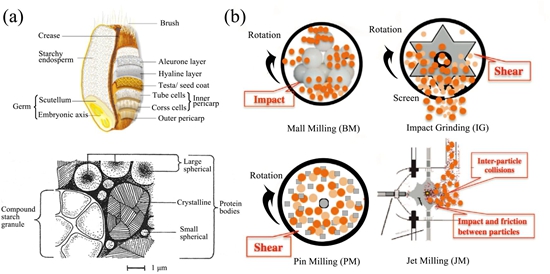Electrostatic Separation Technology for Obtaining Plant Protein Concentrates: A Review
Recently, the Innovation Team of Food Nutrition and Functional Factor Utilization of Institute of Food Science and Technology, has conducted a systematic review and summary of research in the field of dry electrostatic separation of plant proteins. The related research result was published in the top journal of Trends in Food Science & Technology (IF: 12.563) with a title "Electrostatic separation technology for obtaining plant protein concentrates: A review".
Replacing energy-intensive animal proteins with plant proteins has become a new way of life in recent years. However, since the traditional plant protein separation technology (wet separation) has a significant negative impact on the environment, water resources and plant protein itself, electrostatic separation based on the difference of tribo-charging characteristics between plant protein and other components has been developing rapidly in recent years as a new dry separation method. A review of the relevant literature shows that factors affecting the final protein separation efficiency exist at all stages, from the pretreatment effect of the material (particle size, moisture content, etc.) to the construction of the separator (tribo-charging material, pipe length, electric field voltage magnitude, collection chamber location, etc.). The separation efficiency of protein can be further improved by cyclic separation or a combination of separation methods (e.g. air classification). However, although the proteins obtained by electrostatic separation retain their natural functional properties, they are still affected by other confounding components such as phenols or starch. Therefore, electrostatic separation techniques still face limiting problems to be solved before they can be widely used.
Zhu Hongguang is the first author, Professor Tong Litao and Professor Li Zaigui are co-corresponding authors. This work was supported by the National Natural Science Foundation of China [31972005] and the Earmarked Fund for China Agriculture Research System [CARS-07-E− 4].

Fig. 1 (a) Histological composition of a wheat grain and compound starch granule in the endosperm subaleurone layer. (b) Schematic diagram of different methods of milling.
Link to the paper: https://doi.org/10.1016/j.tifs.2021.04.044
By Sun Jing (sunjing@caas.cn)
-
 Apr 18, 2024Opening Ceremony of the Training Workshop on Wheat Head Scab Resistance Breeding and Pest Control in Africa Held in CAAS
Apr 18, 2024Opening Ceremony of the Training Workshop on Wheat Head Scab Resistance Breeding and Pest Control in Africa Held in CAAS -
 Apr 03, 2024IPPCAAS Co-organized the Training Workshop on Management and Application of Biopesticides in Nepal
Apr 03, 2024IPPCAAS Co-organized the Training Workshop on Management and Application of Biopesticides in Nepal -
 Mar 28, 2024Delegation from the School of Agriculture and Food Science of University College Dublin, Ireland Visit to IAS, CAAS
Mar 28, 2024Delegation from the School of Agriculture and Food Science of University College Dublin, Ireland Visit to IAS, CAAS -
 Mar 25, 2024Director of World Food Prize Foundation visited GSCAAS
Mar 25, 2024Director of World Food Prize Foundation visited GSCAAS -
 Mar 20, 2024Institute of Crop Sciences (ICS) and Syngenta Group Global Seeds Advance Collaborative Research in the Seed Industry
Mar 20, 2024Institute of Crop Sciences (ICS) and Syngenta Group Global Seeds Advance Collaborative Research in the Seed Industry
